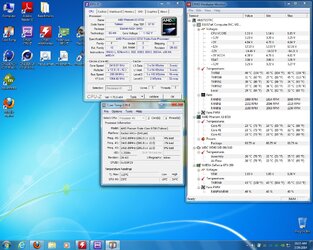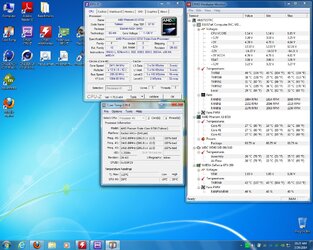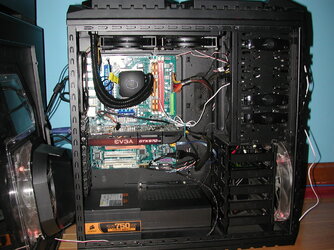- Joined
- Dec 14, 2010
After my experience with the Sempron 145 single core last week I started thinking about the fact that I have a few AM2/AM2+ processors sitting around that I haven't done anything with yet. Tested them a couple years ago, but never tried to overclock them or do any tweaking.
So, this is exploring new ground for me, as I've never really done anything with a Phenom I processor (or anything on AM2/AM2+). Don't know what to expect, results might be good, or might be bad. I'm expecting a lower overclock than AM3 processors though, and probably something closer to what I've come to expect on S939. I've got a couple of Windsor CPU's too, hopefully I'll get to them sometime within the next week or two.
So, let's see what my Phenom X3 8750 Toliman can do. It's the non-Black Edition, so results will probably be lower than the Black Edition. Oh well, it's what I've got.
The board in use is my Asus M2N32-SLI Deluxe (590 SLI chipset), cooling is my Thermalright Ultra 120 Extreme (TRUE), memory is 2x1GB set of Crucial Ballistix .16FD3 with Micron D9 memory chips.
Once I'd gotten the OS and programs installed I noticed the board has an odd issue with the CPU vCore. I had it set at the stock VID of 1.25V in the bios, but CPU-Z, CPUID Hardware Monitor, and the BIOS hardware monitor were reporting 1.3V. So, I've got a vRaise of 0.05V above what is set in the BIOS for some unknown reason. I checked and the setting that applies +200mV to the CPU is turned off, and I didn't find any other settings that seemed related to raising CPU voltage in the BIOS. Since I've not used any other M2N32-SLI Deluxe boards I'm not certain if this is a feature of the model line or just a quirk with my particular board.
So, I started out by trying to find my lowest stable voltage, systematically lowering it until I couldn't get Prime95 to run (it errored out within a couple of minutes at 1.1V in the OS). The lowest stable voltage turned out to be 1.15V, and I ran the Prime95 blend test with that voltage at stock frequency for a four-hour test which ran successfully with no errors and no warnings.
AMD Phenom X3 8750 non-Black Edition overclock settings
2.4GHz (stock): 1.14-1.15V (1.10V) -M2N32-SLI Deluxe
2.5GHz: 1.14-1.15V (1.10V) -M2N32-SLI Deluxe
2.6GHz: 1.18-1.2V (1.15V) -M2N32-SLI Deluxe
2.7GHz: 1.22V (1.175V) -M2N32-SLI Deluxe
2.8GHz: 1.23-1.25V (1.20V) -M2N32-SLI Deluxe
2.9GHz: 1.26-1.28V (1.2375V) -M2N32-SLI Deluxe
3.0GHz: 1.36-1.38V (1.325V) -M2N32-SLI Deluxe, 1.312v (1.325v) (idle: 17°C) (load: 33°C) -GA-MA790X-UD4P
3.1GHZ: 1.44v (1.45V) (idle: 18°C) (load: 34°C) -GA-MA790X-UD4P
So, this is exploring new ground for me, as I've never really done anything with a Phenom I processor (or anything on AM2/AM2+). Don't know what to expect, results might be good, or might be bad. I'm expecting a lower overclock than AM3 processors though, and probably something closer to what I've come to expect on S939. I've got a couple of Windsor CPU's too, hopefully I'll get to them sometime within the next week or two.
So, let's see what my Phenom X3 8750 Toliman can do. It's the non-Black Edition, so results will probably be lower than the Black Edition. Oh well, it's what I've got.
The board in use is my Asus M2N32-SLI Deluxe (590 SLI chipset), cooling is my Thermalright Ultra 120 Extreme (TRUE), memory is 2x1GB set of Crucial Ballistix .16FD3 with Micron D9 memory chips.
Once I'd gotten the OS and programs installed I noticed the board has an odd issue with the CPU vCore. I had it set at the stock VID of 1.25V in the bios, but CPU-Z, CPUID Hardware Monitor, and the BIOS hardware monitor were reporting 1.3V. So, I've got a vRaise of 0.05V above what is set in the BIOS for some unknown reason. I checked and the setting that applies +200mV to the CPU is turned off, and I didn't find any other settings that seemed related to raising CPU voltage in the BIOS. Since I've not used any other M2N32-SLI Deluxe boards I'm not certain if this is a feature of the model line or just a quirk with my particular board.
So, I started out by trying to find my lowest stable voltage, systematically lowering it until I couldn't get Prime95 to run (it errored out within a couple of minutes at 1.1V in the OS). The lowest stable voltage turned out to be 1.15V, and I ran the Prime95 blend test with that voltage at stock frequency for a four-hour test which ran successfully with no errors and no warnings.
AMD Phenom X3 8750 non-Black Edition overclock settings
2.4GHz (stock): 1.14-1.15V (1.10V) -M2N32-SLI Deluxe
2.5GHz: 1.14-1.15V (1.10V) -M2N32-SLI Deluxe
2.6GHz: 1.18-1.2V (1.15V) -M2N32-SLI Deluxe
2.7GHz: 1.22V (1.175V) -M2N32-SLI Deluxe
2.8GHz: 1.23-1.25V (1.20V) -M2N32-SLI Deluxe
2.9GHz: 1.26-1.28V (1.2375V) -M2N32-SLI Deluxe
3.0GHz: 1.36-1.38V (1.325V) -M2N32-SLI Deluxe, 1.312v (1.325v) (idle: 17°C) (load: 33°C) -GA-MA790X-UD4P
3.1GHZ: 1.44v (1.45V) (idle: 18°C) (load: 34°C) -GA-MA790X-UD4P
Last edited:



